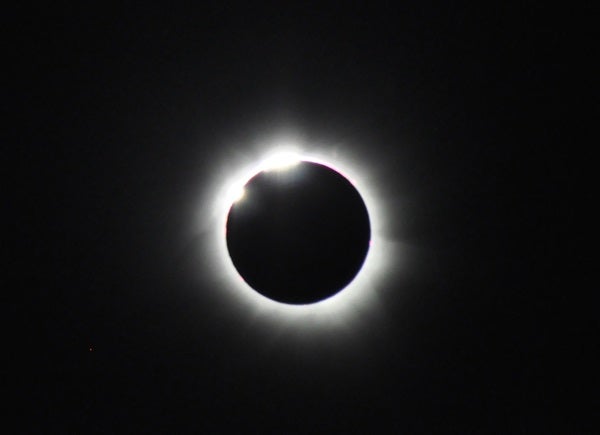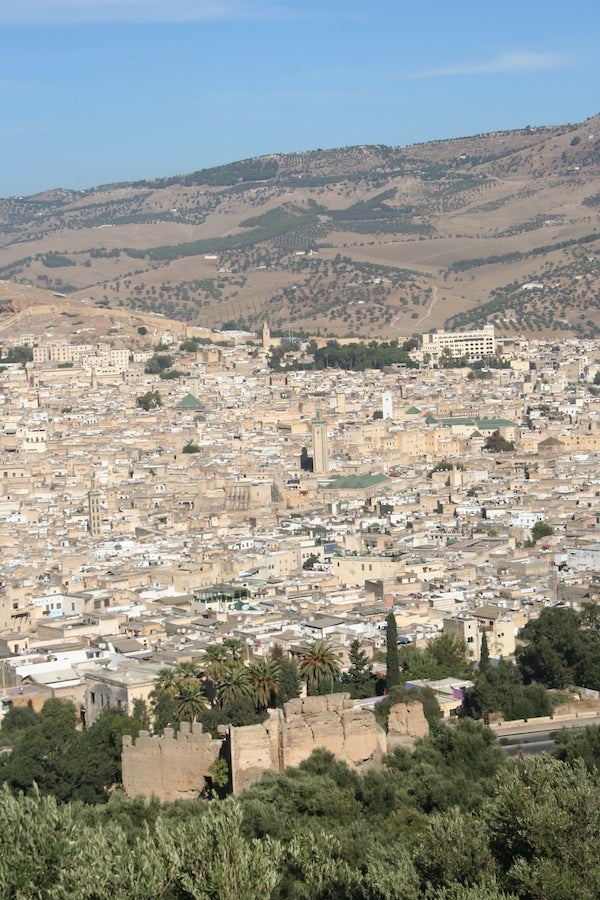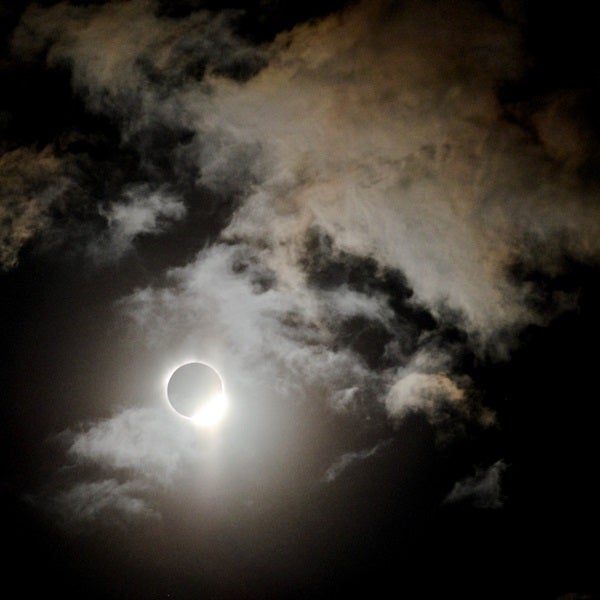This article originally ran in the June 2014 issue of Astronomy.
The total solar eclipse on November 3, 2013, passed over a narrow swath of central Africa, and I was lucky enough to witness it. I, along with 29 travelers on an MWT Associates tour, journeyed to Gabon — a country on the continent’s western coast — to watch the Moon blot out the Sun. Luck was on our side that day.
On our way to Gabon, we had a 10-hour layover in Casablanca, Morocco, where we got to see some of the city’s most important sites. One of those was the gorgeous Hassan II Mosque. Work began in 1986 and was completed in 1993; artisans incorporated an amazing amount of craftsmanship in just seven years.
The mosque, the third largest in the world according to our tour guide, can fit 25,000 worshippers with another 75,000 on the surrounding grounds. This is the only mosque in Morocco open to non-Muslims, and seeing it was an honor. Patterned tile mosaics mirroring the colors of the sea — a mixture of greens, blues, teals, and browns — filled the interior and paneled the exterior. Carved cedar decorated the ceilings. Every material within the building, except for the chandeliers and two white marble columns, came from Morocco.
In Casablanca, we also viewed the courthouse, built in the 1940s, and the entry gates to the king’s palace. Both sites featured stunning artistry: incredible tile work, carved plaster and wood, and ornate metalwork. After our tour, we went back to the airport for a five-hour flight to Gabon.
Eclipse day
We settled into our hotel and got a taste of the Gabonese culture before traveling about 130 miles (205 kilometers) southeast of the country’s capital, Libreville, to view the eclipse. The site was an elementary school, and many locals joined us for the solar spectacle.
The day began a bit harrowing as dense gray clouds filled the sky. Our drive to the eclipse site was also a bit concerning. The bus 15 other travelers and I were on pulled off the road, and we smelled burnt rubber. One of the engine’s belts had broken. Luckily, we had two buses, so the 16 of us joined the other 14 group members — plus a driver and a guide — in the other vehicle. It was a tight squeeze, but it was well worth it: We arrived at the observing site in plenty of time.
Even though the clouds didn’t look like they would break, people enjoyed the atmosphere. Locals filled the street, swaying palm branches and dancing. Children at the elementary school were laughing. And imagine our surprise when, shortly after first contact, the Gabonese president and his family came to the same site to (hopefully) watch the Moon cover the Sun.
About one-third of the way into the partial phase, blue began to peek through the clouds, and about 30 minutes later, a clear sky greeted us. Colors became more saturated. Birds flew lower, as if at dusk. Just before totality, Baily’s beads glimmered, and then the diamond ring flashed. During the eclipse, the temperature dropped dramatically.
We saw the Sun’s corona glow around the covered solar disk during the 1 minute, 5 seconds of totality. Screams of excitement and amazement echoed through our observing site. Locals played drums, children danced, and members of our group hugged one another — ecstatic to have just witnessed totality.
This was my first eclipse, and I couldn’t wipe the smile off my face. I was lucky enough to experience one of nature’s greatest shows, and I will never forget it. But that was just the start of our journey in Africa.
Moroccan culture
The day after totality, we left Gabon and returned to Morocco for a weeklong tour of the country. First up was Marrakech. There, we visited the Bahia Palace, the Saadian Tombs, the main market (called a “souk”), and an apothecary. At the apothecary, a pharmacist introduced us to local products like ointments for eczema and chapped lips, oils for sore throats and puffy eyes, and even natural lip color (from poppies).
After Marrakech, we made our way through the southeastern part of the country, over the Atlas Mountains. We visited the Todra Gorge, a canyon carved by the Todra and Dadès rivers. Beautiful vegetation ran along rivers and creeks in this region. The area had fig trees, alfalfa, fava beans, pomegranate bushes, and a variety of palm trees — including date palms. (The dates were delicious.) I certainly hadn’t expected to see lush vegetation so near the Sahara and can imagine why those who lived nearby fought to keep the land.
Throughout our Moroccan travels, our guide reminded us of the many different tribes that live in the country. Tribal members are known as Berbers, and they make up about 40 percent of Morocco’s population. While there are four main groups, the number of tribes is in the hundreds. Each tribe also has its own symbol and a slightly different style of dress.
Our travels through the North African country showed us villages with buildings made of sundried clay and straw that blend into the hills and mountains. We visited many different shops filled with embroidery and weaving (both lush fabrics and rugs). We even rode camels along the Sahara, where we trotted on the tops of dunes to get to a peak, sat down, and less than five minutes later, watched the Sun set behind the Atlas Mountains. What an experience!
Our group of 30 then explored the fossil-rich region of Morocco near the city of Erfoud. Millions of years ago, a sea covered the now-arid land, and the preserved remains of the animals that lived within it are embedded in rock formations. We walked across one of these ancient formations to take a closer look at the fossilized orthoceras and ammonites. I had never seen fossils in any setting other than a museum.
We continued the theme and stopped at a “fossil factory” where workers cut slabs of marble and chunks of rock — both holding fossils — to then polish the marble into decorative pieces or chisel out individual fossils. A worker showed us how they do the latter; each one takes some three days of labor.
Our next stop was the Taddart Museum, which had hundreds of fossils, minerals, and meteorites on display. All of the 50 or so meteorites had dark fusion crusts and aerodynamic shapes — evidence of their having fallen through Earth’s atmosphere.
After leaving the Moroccan desert, we headed to the imperial city of Fes. We navigated the city’s souk with our guide leading the way — we would have been lost for days without his help — and had one of the best meals of my life. We visited the tanneries and watched workers prepare leather in the traditional way. After leaving the souk, we toured a pottery center, filled with gorgeous tile work synonymous with Morocco.
A look back
My group of 30 traveled to Africa for the total solar eclipse and left with incredible memories. We experienced both Gabonese and Moroccan cultures, opened our eyes to the way people across the globe live, and felt awe viewing the magnificent artistry.
America, Gabon, and Morocco certainly differ greatly, and experiencing these variations is part of the charm of traveling — to learn about the differences and appreciate global cultures. I enjoyed those two weeks in Africa and can’t wait to explore another part of the world during a future eclipse.













